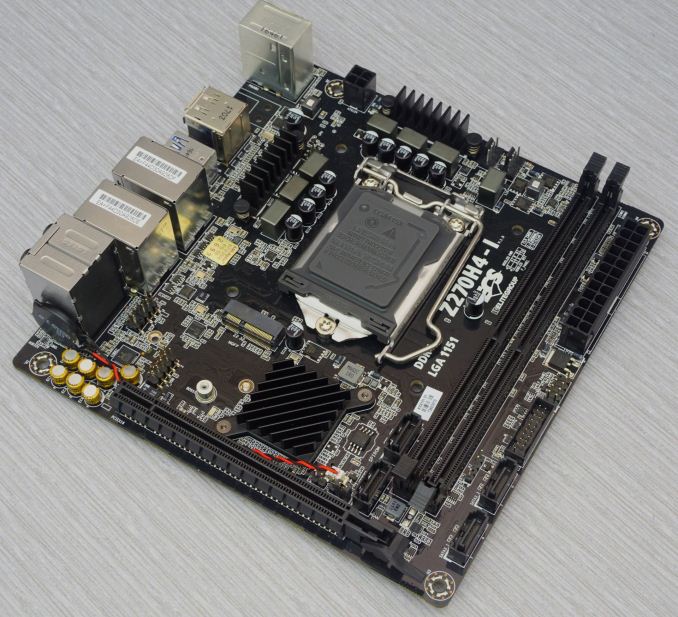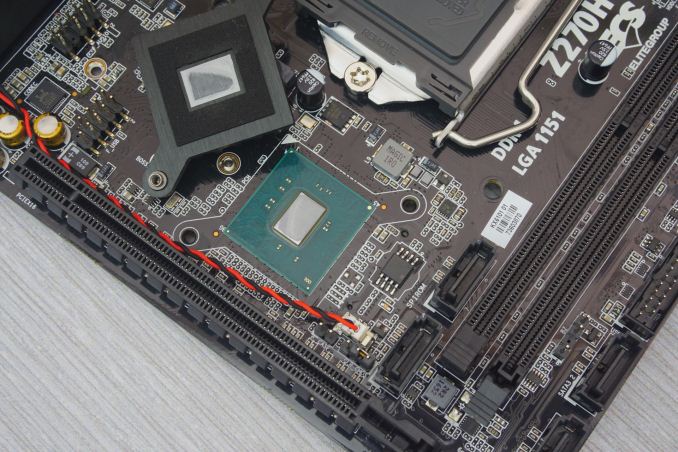The ECS Z270H4-I Durathon 2 Mini ITX Motherboard Review
by E. Fylladitakis on September 5, 2017 10:30 AM ESTConclusion
ECS has set a clear target for the Z270H4-I Durathon 2 Mini ITX and that target is mainstream and casual gamers that want to build a simple, compact, cost effective gaming system. The number of supported devices is adequate for a Mini ITX system, allowing the installation of one M.2 2242/2280 SSD and up to additional four SATA devices, which is sufficient for a typical gaming/entertainment system. ECS was also generous with the USB connectors. With five USB 3.0 Type-A, one USB 3.0 Type-C and two USB 2.0 connectors at the rear I/O panel, plus more via the onboard headers, the designer was clearly trying to ensure that there will be enough connectors for several peripherals and multiple input devices, such as gamepads and other gaming controllers. However, the lack of a USB 3.1 chipset will not go unnoticed if the user owns USB 3.1 peripherals, especially if these are storage devices.
The subsystems of the Z270H4-I Durathon 2 Mini ITX are very good for gamers and home users. Two different, high-performance Gigabit LAN controllers quite possibly were an exaggeration on a motherboard aiming to stay cost-effective, as typical gamers and home users very rarely need to join two different networks or team bond the connections (which is not usually seen across different NIC vendors). The implementation of the Realtek ALC1150 CODEC could have been a little better, as the audio quality of this chipset is good but, according to our testing, it appears that there is a significant level of interference. This will not be noticeable by most people but trained ears and audiophiles are very likely to realize the difference.
Rating the overall design and quality of the Z270H4-I Durathon 2 motherboard is a complicated matter. We need to be lenient here, as the designers have only so much space to work with on a 17 cm × 17 cm Mini ITX board. The placement of most headers and ports is functional, with the possible exception of the two SATA ports that were placed in between the GPU, DIMMs, and the CPU cooler, making them practically impossible to reach once the system has been assembled. The components are all coming from reputable manufacturers, improving the long-term reliability of the motherboard. However, we would have liked to see better heatsinks (or at least heatsinks that make full contact with the components) on a motherboard that is being marketed towards overclockers.
Speaking of overclocking, the ECS Z270H4-I Durathon 2 is not a motherboard that we would recommend to any advanced overclocker. The BIOS options are there and their theoretical range is excellent but the Z270H4-I Durathon 2 lacks both the thermal performance and power circuitry required for extended overclocking. Our test sample downright refused to drive our 7700K processor beyond 4.5 GHz, no matter the settings. It is likely that this may be resolved via a future BIOS upgrade, yet we would still not recommend pushing this particular motherboard with high frequency and voltage settings, as it is not designed to handle such abuse and will place its reliability at serious risk.
The CPU and gaming performance of the Z270H4-I Durathon 2 is good. There is virtually no difference between the Mini ITX Z270H4-I Durathon 2 and the ATX motherboards that we have recently reviewed on CPU and gaming benchmarks. Its DPC latency is a little high but it does not reach figures that would have us worry. For typical gaming systems, the Z270H4-I Durathon 2 will perform as expected. The regular home user and typical gamer will find the Z270H4-I Durathon 2 to be an adequate, cost effective solution for a typical home entertainment/gaming system. More advanced users and especially overclockers are unlikely to be satisfied by the simplicity and poor overclocking capabilities of the Z270H4-I Durathon 2, forcing them to look at more expensive solutions.












19 Comments
View All Comments
jabbadap - Tuesday, September 5, 2017 - link
Erhm Your spec table says "Onboard M.2 none", yet there is one m.2 slot behind the motherboard if I'm not mistaken.Interesting little guy, though I would not OC with that tiny vrm heatsinks it has.
Ryan Smith - Tuesday, September 5, 2017 - link
Thanks!(There are actually 2, one on top and one on the underside of the board)
jtd871 - Tuesday, September 5, 2017 - link
Thanks for the review.The lustre on the 200-series is wearing a bit thin, however, with Intel wooing consumers with the next-gen CPUs and chipset, so I'm not surprised to see some manufacturers trying to drum up a bit of business to move some inventory.
I've always been a bit confused as to why motherboard manufacturers appear to cheap out on their mITX offerings (since mATX and mITX would seem to be better suited to the capabilities of the Z-series chipsets with the inherent limitations on PCI lanes than full ATX or E-ATX boards).
Notes to mobo manufacturers and designers, here are some ideas on how to differentiate your product to consumers (other than price):
1) Don't cheap out on the audio codec. Use the latest and greatest.
2) If you're offering a Z-series chipset, include the power phases and connectors requires to overclock the top-of the line CPU SKU for the chipset, and choose heatsinks based on performance rather than looks.
3) Consider dropping the number of SATA connections to 2: mITX systems generally don't run more than 2 SATA drives, and many these days just run a NVMe drive. Of the SATA connections you do offer, make them RAID-able. Use the freed-up HSIO lanes for more the latest I/O connectors.
4) Especially for mITX, use the physically smallest I/O connectors practical and locate them, or at least 1 of each type, where a full-length PCIe card won't obstruct them.
5) Include diagnostic LEDs (or even a separate diagnostic PCB that connects to a header on your board?) (to save space).
6) Shamelessly copy (and, by all means, improve on) the best and most innovative features of your competitors' boards and BIOS.
7) Read your product's reviews. Especially the critical ones.
Brianmmm - Monday, September 18, 2017 - link
Maybe you're thinking of something like this? I have one, it rocks.http://www.anandtech.com/show/9854/asus-maximus-vi...
nathanddrews - Tuesday, September 5, 2017 - link
I got really excited when I saw "Durathon" because I thought it was some new AMD chip I didn't know about.MajGenRelativity - Tuesday, September 5, 2017 - link
Return of the Duron?artk2219 - Tuesday, September 5, 2017 - link
You joke but i'd love to see that. Maybe name the new Raven Ridge APU's with failed GPU's Durons instead of athlons? Probably not, since sempron took Durons place, but i wouldnt mind it :).BrokenCrayons - Tuesday, September 5, 2017 - link
Eh, I know it's interesting and sometimes fun to overclock, but the performance benefit is typically insignificant without water cooling or a very large air cooler. Both of those cooling setups demand physical space so they increase the size of the system and that takes away some of the point in getting a Mini-ITX motherboard in the first place. ECS might be touting it as a feature, but I can't see it being a key selling point to even the small form factor gamer audience targeted by this motherboard. It probably doesn't matter much that its a rather limited capability of the board.DanNeely - Tuesday, September 5, 2017 - link
As I've observed before, the MITX mobo form factor is trying to serve two masters with different needs, desires, and general system configurations.The first - and who the form factor was originally created for - are people who want as small of a system as possible (but who don't find the NUC/etc compelling for whatever reason). For these people, you're right that any OC feature is likely to be unused. However they're not who it's being intended for.
The second group of people building mITX are conventional gamers who've decided that other than a single GPU they have zero need of PCIe expansion slots, and thus no need for a larger mATX/ATX motherboard. They're still building conventional gamer type systems with a large enough PSU and sufficient cooling to consider an OC because they're using cases only a few inches smaller than what would be normal with an mATX build.
btmedic04 - Wednesday, September 6, 2017 - link
Im surprised ECS is still around. I haven't used one of their products since the G45/intel pentium dual core system I put together for my dad way back when.As for the overclocking options, I could see them possibly being useful in an undervolting/underclocking scenario (say a passive build) or paired with a pentium g3258-like processor (please intel! the i3 7350k is overpriced for what it is)